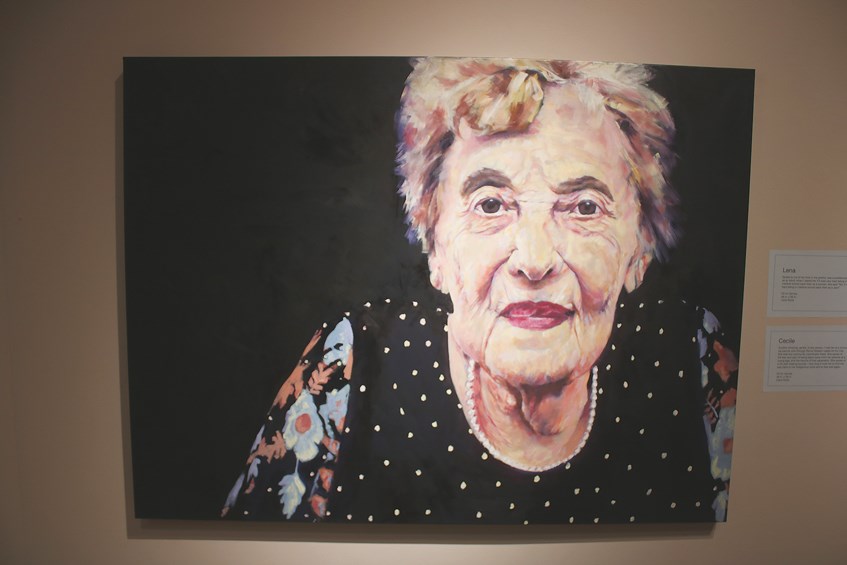A new show launched Sunday at the Godfrey Dean Gallery in the city by Carol Wylie a portrait painter living in Saskatoon.
Entitled; ‘They Didn’t Know We Were Seeds’ the show centres on a series of large oil portraits of nine survivors of the Jewish Holocaust and nine survivors of residential schools, created by Wylie.
“This project explores trauma, ongoing recovery, shared pain, courage, and the indomitable human spirit, as well as an enduring hope that, through truly hearing one another’s stories, humanity will someday be characterized more by its compassion than by its capacity for cruelty,” notes the artist.
The idea for the collection came from hearing a speaker talk of their experiences as a Holocaust survivor.
“In April of 2016 I attended the Saskatoon Holocaust Memorial service for the first time in several years. As survivor Nate Leipciger spoke of his horrifying experiences in a Nazi death camp, and his ongoing efforts to educate and shed light on the atrocities, I was, as always, astounded by the extent of abuse the human spirit can endure,” wrote Wylie who is also Jewish in her artist statement.
“Researchers in psychology and sociology have noted connections between the experiences of Jewish holocaust survivors and residential school survivors in Canada. The struggles and generational trauma of Indigenous peoples caused by the residential school experience seems to resonate with Jewish holocaust survivors.”
As an example Wylie told Yorkton This Week Indian Affairs Superintendent Duncan Campbell Scott, in 1910, called residential schools ‘The Final Solution,’ a statement which preceded Adolph Hitler’s similar pronouncement regarding the ‘Jewish problem.’
Wylie said she soon recognized she wanted to do something to allow for survivors of both to have a conversation of sorts with the broader public. As a portrait painter she wanted to create that opportunity through her paintings.
“As a Jewish person, after hearing Nate speak, I felt I needed to somehow honour the memory of these amazing people who endured and survived such horrendous mistreatment. The inclusion of residential school survivors in the project seemed to make sense in light of the connections previously mentioned. I’d also hoped that the act of listening and bearing witness would help me understand that experience a little better and make a small personal step towards reconciliation,” she wrote.
Wylie undertook to paint nine survivors of the Holocaust, noting that she was almost too late in the sense that within a decade no survivors are likely to remain alive. One gentleman who was part of the project has died since Wylie began her work. As it was she had to travel across Canada to meet with those she did paint.
At the same time Wylie also created nine portraits of residential school survivors.
Wylie explained having 18 portraits in the show was important to her as 18 in Hebrew (chai), essentially means life.
As a portrait painter, portraiture was the methodology through which Wylie said she could offer the strongest statement. Through portraits of individual survivors, she hoped “to create a silent dialogue between Jewish survivors and Indigenous survivors,” she said.
For Wylie the process of creating the portraits was deeply personal as she met with all but one of the subjects allowing her time to speak with them, then sketch and photograph the survivors.
Wylie said having a conversation with the survivors was a crucial part of the work.
“Some spoke about it (their experiences) in a lot of detail,” she said, “… Some didn’t talk about it at all.”
Wylie said as might be expected “some have moved past it better, more strongly than others,” while others are still keenly feeling fear, guilt and anger.
That said, Wylie said there is no right, or wrong way to deal with what these people have been through.
“None of this is normal,” she said.
Wylie said obviously too, written records of both the Holocaust and of the residential schools is dramatic, she hopes the portraits add something more personal for those viewing the works.
“After a relatively short period of interaction, for most people, the face reveals all,” she wrote. “A well-done portrait has the potential to be a unique record of the sum of an individual’s experience, offering the opportunity for a form of engagement with that person, even in their absence. My hope is that this work will give viewers a chance to encounter a survivor they may never meet. One personal story often has more resonance than statistical abstractions, no matter how appalling.”
The show will hang at the Godfrey Dean Gallery until May 17.



